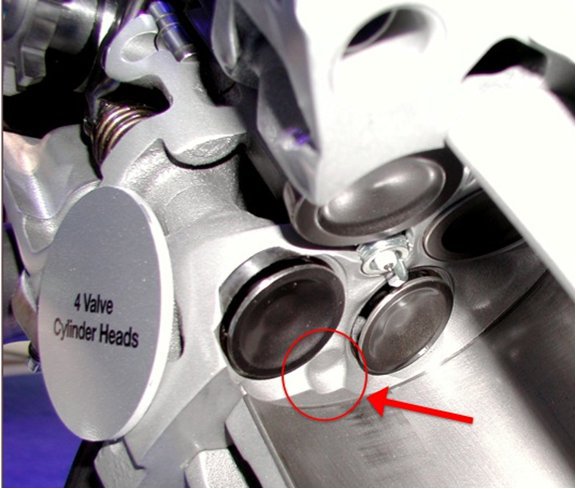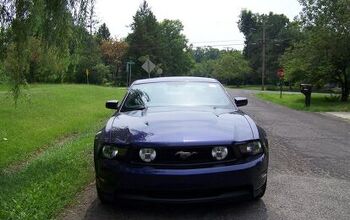Editorial: Do Not Buy A 2011 Mustang 5.0

What you see above is the cutaway of the Ford 5.0L mill, taken from the 2010 New York Auto Show. Formerly known as the Coyote V8, the 5.0-packed 2011 Mustang GT hit the showroom floors, winning rave reviews with every journalist lucky enough to get their hands on one. While blogging for TTAC at the New York Auto Show, I hit up the Five-Oh engine displays at the Ford booth. It was a thoroughly technical and suitably beautiful exhibit. Only problem was, it gave away a secret that nobody should know. Camera in hand, I did the deed: a picture tells a thousand words, but this TTAC Editorial still needs about 800 words to go with.
Take a gander at the 5.0’s combustion chamber, highlighted in red. It’s a strange little bump. And nothing more, right? Sure, unless you read between the (casting) lines: its proof that the 5.0 Mustang shall receive a significant improvement in the near future. Yes, Dearborn’s got a trick up its sleeve: direct injection.
I spoke with one of the well-versed product specialists, a booth babe in true TTAC style, aside from the fact that he was most certainly not a “she.” No, I never asked if he came with the car, but I did challenge him to explain the 5.0’s tempting cylinder head design. And while he never said anything quotable, the look on his face was picture perfect: if I told you, I’d have to kill you.
Typical auto show banter between savvy product specialists and bored car hacks? Perhaps. But the fact remains, nobody should buy a Mustang GT until that casting bump turns into a hole for a fuel injector. But what’s the big deal?
Direct fuel injection, as opposed to (intake) port fuel injection, is the latest technology in the advancement of the internal combustion engine. It’s one of many advancements that proves the piston engine gets better with age, and beats the dubious “Moore’s Law” argument of Tesla fans. And the proof is already on the street: owners of late model diesels, EcoBoost Fords several GM products like the Cadillac CTS already know the drill: direct injection gives more power, more economy and lower emissions with zero changes to the driving experience. It is the textbook definition of having your cake and eating it too.
Geek Alert! Let’s get detailed: a port fuel injection vehicle has the fuel injector placed in the intake manifold, usually at the end of the runner, behind the intake valve. Direct Injection places the injector in the red circle from the picture above: so there’s no more mixing of air and fuel in the intake. The benefit is simple: injecting the fuel at a very high pressure (2000psi, compared to 10-60 psi) directly into the combustion chamber produces a cooling charge. Much to the joy of mechanical engineers everywhere, “cold” fuel gets shot into a hot combustion chamber: Thermodynamics wins. This helps reduce engine knock, so higher ignition timing and/or compression ratios can be implemented. Just like sane doses of Nitrous Oxide on a motor, the extra cooling charge afforded by Direct Injection is a huge win by itself.
The doubters might mention the Jaguar XF makes “only” 385 horses with its direct injected 5.0L mill, which is less than the current Mustang’s 412 ponies. But both 5.0s come from different engine families. And when you consider the Jag’s power bump from port to direct injection, the improvement is real.
Even if my theory is correct, there’s no guarantee that the direct injected Mustang shall be any more powerful than the current model. Ford can pull a fast one: de-tuning the direct injected 5.0 for a multitude of reasons. Thanks to drive-by-wire and traction control nannies, the direct injected 5.0 can easily give 80% of a day’s work and nobody will notice. Considering damn near every vehicle today has power robbing torque management built into its DNA, why would Ford up the Mustang to its full potential?
Go back to 1986: the year that port fuel injection (@200hp/285tq) took the 5.0’s game to refined places the Holley four-barrel (@210hp/270tq) of 1985 couldn’t even imagine. Torque went up, but the 1986 Mustang lost 5% in peak horsepower. Cue the modestly-redesigned 1987 Mustang: a quickie head swap to ye olde F-150 parts turned the Mustang’s EFI 5.0 (@225hp/300tq) into the real deal. That’s a healthy 7 and 11% increase in hp/tq over 1985’s tried and true Holley carburetor. All of which signaled the end to our fascination with glorified toilet bowls on engines. For the better!
Imagine if the direct injected 5.0 pulls a “1987” on us: the 412hp/390tq we see today will be nothing compared to the 441hp/433tq of our near future. It’s entirely possible. But will history repeat itself? Don’t say I didn’t warn you.

More by Sajeev Mehta
Latest Car Reviews
Read moreLatest Product Reviews
Read moreRecent Comments
- Michael Gallagher Some math! The cost to produce US Shale derived oil is between $35 to $55/bbl. Middle East oil cost about $15/bbl. If OPEC wanted, they could produce more , driving oil prices below our costs and decimating our domestic industry. We have whispered in their ear that they should endeavor to keep the price above our cost, in exchange for political, economic and security favors. Case in point, during COVID when gas dropped below $2/gal , producers were losing money, Trump had to approach the Saudis requesting them to cut production to raise the oil price above our cost. If the global oil industry was truly competitive, our industry would be out of business very quickly due to our much higher cost of production. Those that long for those covid prices need to realize it would be at the expense of our domestic industry.
- Norman Stansfield I'm training to be a mechanic, and have been told this or a Harley would be a good start.
- SilverHawk I watch out of loyalty to the sport even though it's often not as entertaining these days. But then, you have a race like Miami that gives us a driver's first win and my enthusiasm is refreshed. Congrats to Lando.
- Oberkanone Nope. No interest.
- SilverCoupe Tim, you don't always watch F1 as you don't want to lose sleep? But these races are great for putting one to sleep!I kid (sort of). I DVR them, I watch them, I fast forward a lot. It was great to see Lando win one, I've been a fan of McLaren since their heyday in CanAm in the late '60's.

































Comments
Join the conversation
I just clicked on the article in hot rod magazine regarding the coyote. According to Ford engineers direct injection is only useful in turbo or supercharged engines, and that the advantage of DI over port injection in naturally aspirated engines is only around 1 percent.
@auotdoctor, if the plug wires were removed on the vette then how did it shoot flames from the throttle bodies? The spark plugs would not have been firing.